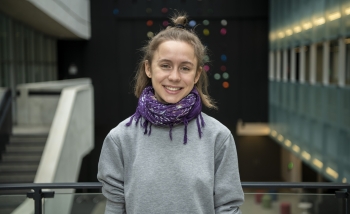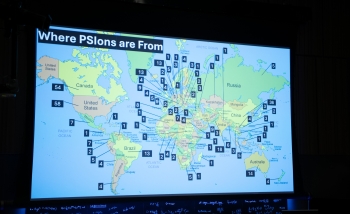Perimeter Institute alumni have gone on to a wide variety of roles after leaving the Institute. There is a surprising amount of physics in medicine, and Rowan Thomson is using her background in theoretical physics to develop new and more precise cancer treatments. We sat down with Rowan Thomson to learn more about her journey.
This interview has been lightly edited for clarity and length.
What is your current role, and how are you trying to push boundaries in your field?
I am Professor of Physics and Associate Dean (Equity, Diversity, and Inclusion; EDI) in the Faculty of Science at Carleton University. I develop theoretical approaches and computational techniques to study the interactions of radiation with matter, often considering applications in radiation medicine. Having a PhD in theoretical physics and now working in a different field – medical physics – means my perspective is never limited: my research is constantly pushing boundaries.
My team developed egs_brachy, the fastest accurate open-source code in the world for calculating radiation dose for brachytherapy, a type of cancer treatment with radiation sources within/near the tumour. We’re now collaborating with radiation oncologists to advance treatments. My team also developed novel approaches for bridging scales – from patient to cell to nanoparticle – in Monte Carlo simulations for the development of novel treatment approaches and advancing knowledge in radiation medicine. We work with biologists, data scientists, and experimentalists to advance our understanding of biological responses.
Challenges to EDI affect who does science and their experiences, how science is done, and society-science alignment; but science is for everyone – a simple statement with many dimensions. I enthusiastically define and mobilize actions to effect change in STEM, transcending disciplines, fields, and organizations.
What brought you to where you are now?
After successful completion of my PhD in string theory at Perimeter (late 2007), I transitioned to the applied specialization of medical physics, starting as Assistant Professor in late 2010. This unusual research trajectory gives me the ability to investigate subjects that not many in the world can investigate, spanning fundamental radiation dosimetry to quantum theoretic modelling of low-energy radiation interactions with DNA.
Valuable opportunities have propelled my research and sparked new creative directions. For instance, my appointment as a Canada Research Chair provided time and freedom for research, and being named the inaugural Associate Dean (EDI) provided a leadership platform to foster meaningful change. Many factors have contributed to my success. My love for physics and math, and enthusiasm for learning and sharing knowledge, have shaped my path. I am able to see beyond disciplinary boundaries, something that may stem from my transition between physics fields. I’ve been fortunate to have the support of important people throughout my journey: mentors, students, collaborators, and my family.
What are you passionate about?
I am an avid cross country skier, and while I don’t race any more, I love to ski with my family in the Gatineau Park north of Ottawa. Our ski distances keep getting longer, enabling us to reach small cabins where we can warm our lunch over the wood-fire stove. When there is no snow, I love to run on the trails in the Gatineau as well as in green spaces near the waterways of Ottawa. I grow vegetables – everything from leafy greens and potatoes to basil and six varieties of heirloom cherry tomato.
How has your work impacted your industry and community?
The results of my research program are directly impacting medical physics and radiation oncology research and practice globally. My work has produced world-leading, open-source code (egs_brachy) and pioneered state-of-the-art radiation dose evaluations, which are critical for planning treatments and understanding outcomes. There has been uptake of my research results by knowledge users globally, as evidenced by their inclusion in professional practice guidelines and reference materials such as the American Association of Physicists in Medicine Task Groups. Researchers worldwide use my egs_brachy code and publish their novel results. We are currently deploying egs_brachy at cancer centres across Canada for breast/prostate cancer research. My group’s work on multiscale modelling (from nanoparticles to cells to patients) has implications for prospective treatment techniques (using nanoparticles), measurements of cellular radiation response (Raman micro-spectroscopy), and existing radiation medicine procedures (mammography; Greenfield Award; Fedoruk Prize).
My EDI work has garnered considerable attention (my Physics Today article was a top article of 2022), and I’ve received invitations to give invited/keynote presentations (inter)nationally (LBNL, NRC, TRIUMF, Physics Today Webinar), with presentations attracting hundreds of scientists. Audiences tell me that the practical tools (teaching toolkit; research pocket guide) developed by my team are highly useful in integrating EDI into their scientific activities.
How do you give back to your community?
I strive to provide outstanding mentorship. I mentor my own students/postdocs and others. My mentees thrive in activities spanning the breadth of discovery science to applications, as well as in outreach (Let’s Talk Science), leadership (national student councils), and advancing EDI (#StrikeForBlackLives, survey). My students are co-authors on 45 articles in top journals with five articles highlighted “Editor’s Pick”; one was awarded the international Greenfield Award and Fedoruk Prize. My mentees go on to highly rewarding and impactful positions in the private sector, healthcare, academia, and government.
I engage in outreach, including presenting research to the public (Science Literacy Week, Ottawa Public Library), high school students (Enrichment Mini-Courses), and teachers-in-training. I was an expert on the TVOntario kids show “The Prime Radicals.” I was interviewed for “Spotlight with Scientists in School.” As the inaugural Associate Dean (EDI) at Carleton, I lead the integration of EDI best practices across the Faculty of Science (Tenure/Promotion; Indigenous initiatives) and chair the Science EDI Committee. I co-chair Carleton's Joint Committee on Employment EDI. I have been invited to take on EDI-related leadership roles in professional societies, such as the EDI Implementation Committee of the Canadian Association of Physicists, Working Group on Science Council EDI of the American Association of Physicists in Medicine.
About PI
Perimeter Institute is the world’s largest research hub devoted to theoretical physics. The independent Institute was founded in 1999 to foster breakthroughs in the fundamental understanding of our universe, from the smallest particles to the entire cosmos. Research at Perimeter is motivated by the understanding that fundamental science advances human knowledge and catalyzes innovation, and that today’s theoretical physics is tomorrow’s technology. Located in the Region of Waterloo, the not-for-profit Institute is a unique public-private endeavour, including the Governments of Ontario and Canada, that enables cutting-edge research, trains the next generation of scientific pioneers, and shares the power of physics through award-winning educational outreach and public engagement.
You might be interested in




